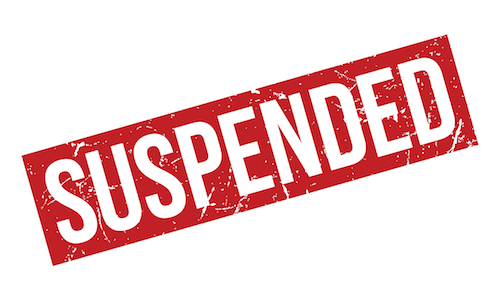Top 10 Ethics Traps
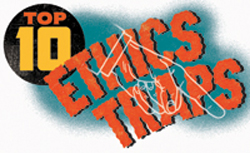
Illustrations by Lou Brooks
Click here to download this CLE audio program for free.
Perhaps there was a time when ethics rules for lawyers were straightforward and following them was largely a matter of professional common sense. But it probably ended before your grandfather took down his shingle.
Today it’s a much different story. As law practice has become more complex, so have professional conduct rules—at least in their practical application.
“There are still bright lines, but there are lots of ambiguities,” says professor Stephen Gillers, who teaches ethics at New York University School of Law. “If you think it’s just about the basics, you’re on the road to perdition.”
With help from Gillers and other experts on professional conduct, the ABA Journal presents its list of the 10 top ethics traps for lawyers. Some of these traps might seem a bit arcane, others obvious. But according to our experts, lawyers in all practice fields fall into them regularly—sometimes with disastrous effects.
[We cite the ABA Model Rules of Professional Conduct, which have been adopted—sometimes with variations—by most states. Lawyers should consult the specific professional conduct rules that apply in their own jurisdictions.]
THE TRAP: Stumbling into a Lawyer-Client Relationship
Phoenix attorney Douglas L. Irish represented Motorola Inc. in a legal dispute over the possible sale of its machine shop to another company.
But M. Dean Corley, a retired Motorola employee who had managed the shop, believed that Irish and his firm, Lewis and Roca, also represented him. And when Corley said as much in a deposition, Irish didn’t correct him.
When Motorola threatened to sue Corley for talking to the prospective buyer about working with the company after the sale, he tried to disqualify Irish and his firm from representing Motorola.
Irish responded that he had never represented Corley, but by then it was too late. U.S. Magistrate Judge Lawrence O. Anderson ruled that Corley had shared confidential information with Irish in the belief he was Corley’s lawyer, and that Irish had a conflict of interest.
The judge allowed the firm to continue representing Motorola, subject to court-imposed safeguards to protect Corley’s interests. Advanced Manufacturing Technologies Inc. v. Motorola Inc., No. CIV99-01219PH XMHMLOA (D. Ariz. July 2, 2002).
THE WAY OUT: Don’t Be Vague
BY MICHAEL DOWNEY
Virtually everyone is a potential client. If a lawyer isn’t careful, someone may inadvertently become an actual client—or think he or she is—often with grave consequences.
While the ABA Model Rules of Professional Conduct are silent on the formation of a lawyer-client relationship, the Restatement (Third) of the Law Governing Lawyers provides in section 14 that the relationship is formed when a person manifests an intent that a lawyer provide legal services, and the lawyer either (a) manifests consent or (b) fails to manifest lack of consent and knows or reasonably should know the person reasonably relied on the lawyer to provide the services.
In other words, if a person asks a legal question, and a lawyer answers or says he or she will look into it, a lawyer-client relationship may result. There’s no need to sign an agreement, shake hands, discuss rates or send an engagement letter.
Once a person becomes a client—even inadvertently—it triggers all the obligations of the attorney-client relationship: loyalty, competency, diligence and confidentiality. Further, under ABA Model Rule 1.10, an inadvertent client relationship imputes to the lawyer’s firm, not just to the lawyer.
In Togstad v. Vesely, Otto, Miller & Keefe, 291 N.W.2d 686 (Minn. 1980), the court upheld nearly $650,000 in judgments against a firm that thought it had declined a representation. The court ruled that an inadvertent lawyer-client relationship had been created, and thus the firm should have advised the plaintiff about the statute of limitations that governed her original claim.
Lawyers who aren’t careful to avoid inadvertent clients may face malpractice claims, disqualification—or worse.
Michael Downey is a partner at Hinshaw & Culbertson in St. Louis. He chairs the Ethics and Technology Committee in the ABA Center for Professional Responsibility.
THE TRAP: Overlooking the Marketing Rules
A North Carolina lawyer who markets and provides legal services over the Internet under the name Virtual Law Firm sought the advice of the state bar on how certain professional conduct rules applied to it.
The resulting ethics opinion states that, while there is no prohibition against lawyers using the Internet for communication purposes, “Cyberlawyers have no control over their target audience or where their marketing information will be viewed. Lawyers who appear to be soliciting clients from other states may be asking for trouble.”
At a minimum, the Virtual Law Firm must comply with North Carolina’s rules for lawyer advertising, the opinion states. That means the site must list an actual office address, identify the lawyer or lawyers primarily responsible for the Web site, and identify the jurisdictional limits of the practice.
“A prudent lawyer may want to research other jurisdictions’ restrictions on advertising and cross-border practice to ensure compliance before aggressively marketing and providing legal services via the Internet.” North Carolina State Bar, 2005 Formal Ethics Opinion 10 (Jan. 26, 2006).
THE WAY OUT: Translate for the Internet
BY DIANE L. KARPMAN
Thirty years ago, in Bates v. State Bar of Arizona, 433 U.S. 350 (1977), the U.S. Supreme Court laid out the fundamentals of acceptable lawyer advertising: It must not be false, deceptive or misleading. From these three simple ideas, all 50 states have crafted increasingly byzantine rules.
It is nearly impossible to comply, especially on the Internet. States have different retention policies, label requirements and even rules for type size. Rules regulate content like testimonials, comparisons and monikers (“pit bulls,” “heavy hitters”). Recently New York attempted to prohibit pop-ups in electronic advertising. Alexander v. Cahill, No. 5:07-CV-117 (N.D.N.Y. July 23, 2007).
These advertising rules for lawyers were designed for print media and never anticipated YouTube or Second Life. Half the lawyer ads on YouTube spoof the profession. But parody and satire are inherently confusing unless you “get it.” And poking fun at yourself could be confusing to a consumer.
Reportedly, the Internet is the first place people look for lawyers. How can you take advantage of that amazing marketing potential?
Obviously, comply with your home state’s regulations. Include whatever disclaimers should appear. It’s a good idea to state that the ad does not create an attorney-client relationship or protect any confidential information until a written agreement is signed. (But see Barton v. U.S. District Court for the Central District of California, 410 F.3d 1104 [9th Cir. 2005], for a different approach.) Note that it is void where prohibited by law so you don’t run afoul of other state rules.
Remember that Bates acknowledges a public need to be able to find a lawyer, obtain accurate information and make informed decisions about legal services. You can truthfully communicate facts about your professional services and still have a sense of humor. But be careful. The father of commercial spam—a lawyer named Laurence Canter—was disbarred for using the technique for (among other things) promoting his immigration practice. You can check it out on the Internet.
Diane L. Karpman is principal at Karpman & Associates in Los Angeles, where her focus is on legal ethics and professional responsibility. She is a member of the ABA Standing Committee on Professionalism.
THE TRAP: My Boss Made Me Do It
When John B. Bowden started work as a managing associate for the Forquer Law Firm in Greenville, S.C., he was in for an unpleasant surprise. Bowden discovered that the firm was inflating government recording fees on settlement statements for HUD-1 real estate transactions. When he asked his boss in the Charlotte, N.C., office about it, Robert Forquer told him the practice was legal and ethical.
Wrong answer. The South Carolina Office of Disciplinary Counsel informed Bowden that the firm’s Greenville office failed to keep sufficient records of recording fee charges and failed to track client funds relating to those fees. Even worse, Forquer was apparently using excess fees to cover office expenses and make various payments to himself, according to a ruling by the South Carolina Supreme Court in a disciplinary action against Bowden.
Fortunately for Bowden, he wasn’t aware of the misuse of funds. But in an agreement with the ODC that resulted in a reprimand by the court, Bowden acknowledged that it was his duty to tell clients that their bills were inflated and to assure that HUD-1 forms were accurate in closings he supervised. He also acknowledged an ethical duty to assure that other lawyers in his office complied with state ethics rules. In the Matter of John B. Bowden, No. 25978 (May 9, 2005).
THE WAY OUT: Report Even if it Hurts You
BY KATHRYN A. THOMPSON
Rule 5.2(a) of the ABA Model Rules of Professional Conduct is emphatic: A lawyer is bound by the ethics rules “notwithstanding that the lawyer acted at the direction of another person.” The single exception to this rule is when the lawyer acts in accordance with a supervisory lawyer’s “reasonable resolution of an arguable question of professional duty.”
It’s not enough for a subordinate lawyer to refuse to comply with any unethical directives from supervisors. The lawyer also is bound by ABA Model Rule 8.3 to report the supervisor to an appropriate disciplinary agency if he or she “knows” the other lawyer has committed an ethics violation that raises a “substantial question as to that lawyer’s honesty, trustworthiness or fitness as a lawyer.” This requirement applies even when, as in Bowden, the reporting lawyer risks implicating him- or herself in an ethics breach.
There’s one more thing: Subordinate lawyers also must contend with their obligations toward affected clients under ABA Model Rule 1.6. That rule prohibits lawyers from revealing information about representations unless clients give informed consent or the information falls within an enumerated exception to the rule. And Model Rule 8.3 specifically states that lawyers are not required to disclose information that is otherwise protected by Rule 1.6.
Thus, in reporting the conduct of a supervisor to a disciplinary authority, the lawyer has to take into account what information must be revealed to support the charge. If the information is confidential for purposes of Model Rule 1.6, client consent is generally required before the information may be revealed. To complicate matters, the standard of disclosure may vary from state to state. A recent ethics opinion in Ohio held that a lawyer had a duty to report any misconduct stemming from unprivileged information. Opinion 2007-01, Ohio Supreme Court Board of Commissioners on Grievances and Discipline (Feb. 9, 2007). By contrast, the broader scope of Model Rule 1.6 protects the disclosure of any information relating to the representation (subject to specific exceptions).
This much is certain: Subordinate lawyers who are dragged into the fray when their bosses flout the ethics rules cannot assume their second-chair status excuses them from their professional obligations.
Kathryn A. Thompson is research counsel for ETHICSearch, a service of the ABA Center for Professional Responsibility.
THE TRAP: Law Firm Breakups
When two lawyers left the Chicago firm of Dowd & Dowd in 1990, it triggered a legal battle that was still going on 14 years later.
The primary issues in the case were whether the departing lawyers breached their fiduciary duties to their former employers by using confidential information to help arrange financing for their new venture and by soliciting one of the firm’s clients—a subsidiary of Allstate Insurance Co.—before they resigned.
When the legal dust settled, the Illinois Appellate Court upheld a trial court’s assessment of nearly $2.5 million in compensatory damages, plus $200,000 in punitive damages.
The appellate court noted that lawyers may use lists of clients expected to leave a firm to help obtain financing for their new practice. But in this case, the court stated in its opinion, “The evidence leads to the reasonable inference that the partners actually solicited the Allstate business, secured a commitment from Allstate for future business, and obtained financing based on that commitment—not a mere expectation.” Dowd & Dowd Ltd. v. Gleason, 816 N.E.2d 754 (2004); appeal den., 823 N.E.2d 964 (Ill. 2004).
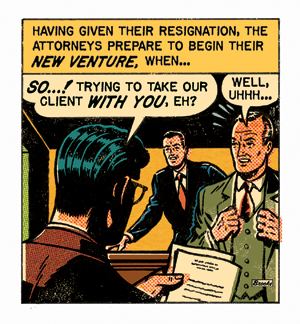
THE WAY OUT: Defer to the Client’s Wishes
BY EILEEN LIBBY
When a law firm breaks up, things can be every bit as acrimonious as the worst War of the Roses marital splits. But who gets custody of the clients?
Rule 1.16 of the ABA Model Rules of Professional Conduct gives the client the unfettered right to choose whether to stay with the original firm or move on with the departing lawyer. Model
Rule 1.4 requires that a lawyer keep the client reasonably informed about the status of the matter, but ethics opinions at the state level differ on whether a lawyer is obligated to inform clients that he or she is leaving the firm.
There is no prohibition in the ABA Model Rules against a departing lawyer advising clients that he or she intends to leave the firm. The nature of the communication is the major concern.
Model Rule 7.3 prohibits a lawyer from soliciting a prospective client either in person or by telephone, but it makes an exception for people with whom the lawyer has had a “prior professional relationship.” In ABA Formal Opinion 99-414 (Sept. 8, 1999), the Standing Committee on Ethics and Professional Responsibility explained that such a relationship does not exist where the departing lawyer had merely worked on a matter “in a way that afforded little or no direct contact with the client.”
Pursuant to rules 7.1 and 7.3, communications by the departing lawyer must not be misleading or overreaching. The communications should not urge the client to sever a relationship with the original firm or disparage that firm. The requirement under Rule 7.3 that written communications to prospective clients be labeled as advertising material do not apply, however, to “neutral” communications that merely notify people with whom the departing lawyer has had a prior professional relationship that the lawyer is changing employment and provide the lawyer’s new address.
Ideally, a departing lawyer and the firm can agree on the content of a joint announcement. The Model Rules do not prescribe the timing of such an announcement, nor do they address the substantive law relating to fiduciaries, “winding up” of partnerships, property and unfair competition. Whether the lawyer can take client lists, continuing legal education materials, practice forms or computer files may turn on principles of property and trade secret law.
Eileen Libby is associate ethics counsel in the ABA Center for Professional Responsibility.
THE TRAP: Communicating by E-Mail
A law firm in Massachusetts maintained a Web site that contained a link allowing visitors to send e-mails directly to lawyers at the firm. But the site contained no warning or disclaimer regarding the confidentiality of the information sent.
So when a company—call it ABC Corp.—sent an e-mail to one of the firm’s lawyers regarding a possible legal action against XYZ Corp., the firm suddenly faced an ethical dilemma because it represented XYZ on another matter.
When the firm sought advice from the Massachusetts Bar Association’s Committee on Professional Ethics, the news wasn’t good. Opinion 07-01 (May 23, 2007).
First, because the firm failed to provide necessary disclaimers, the committee said the lawyer who received the e-mail must maintain the confidentiality of the information furnished by ABC Corp.
And second, the firm may not continue representing XYZ Corp. if protecting ABC Corp.’s confidential information materially limits its ability to represent XYZ.
In this case, a marketing tool intended to help attract clients appears to have lost a firm two of them.
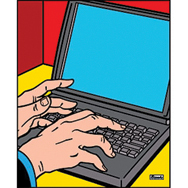
THE WAY OUT: Respect Each E-Mail
BY LAWRENCE J. FOX
E-mails: The greatest of modern conveniences. You can write three while billing someone else.
E-mails: The bane of our existence. Step away from your desk or ignore your BlackBerry for an hour, and 15 more have arrived—all demanding instant responses. For further proof of this mixed blessing, consider these e-mail ethics traps waiting for lawyers and clients.
One way to protect the attorney-client privilege is to add the “attorney-client privileged” label to all communications we think are privileged. Of course, most of us automatically label every e-mail we send that way, just to make sure. Even the order to the deli for five corned beef sandwiches with Russian dressing. If you really want to protect an e-mail, don’t rely on the automatic legend. Label the message itself. Then a judge will know you actually thought about it.
E-mails permit instantaneous communication. It’s way too easy to hit forward and let the whole gang know. They can forward a message on to hundreds more through long strings that add (but rarely subtract) addressees. We know our obligation to protect a client’s confidentiality. So share e-mails only with client representatives who need to know. Watch where your privileged message is going, and make sure your clients do, too.
E-mails accumulate by the millions. Destruction is essential so hard drives don’t crash under an e-mail tsunami. As a result, companies institute policies for discarding the damned things. But when litigation is credibly threatened, a “hold” must be issued, and the deletions must stop. It’s up to lawyers to warn clients when this must occur. The consequences of post-threat destruction are severe indeed, for both client and lawyer.
Lawrence J. Fox is a partner at Drinker Biddle & Reath in Philadelphia. He serves on the ABA Task Force on Attorney-Client Privilege and is a past chair of the Section of Litigation and the Standing Committee on Ethics and Professional Responsibility.
THE TRAP: Failing to Communicate with Clients
In 1997, French lawyer Francois Marland hired the New York City firm of Reid & Priest to represent him in a qui tam action alleging a French bank illegally acquired the assets of an insolvent U.S. insurance company. (The firm, through mergers, became Thelen Reid & Priest; it is now Thelen Reid Brown Raysman & Steiner.) Later, the California Department of Insurance asked the firm to handle its own action against the French bank.
Marland dropped his suit after agreeing to accept a percentage of any fees Thelen Reid got from the California suit. But in 2006, he initiated an arbitration proceeding against the firm claiming that the agreement—under which he received $19 million—was unfair and unenforceable, and that the firm had rushed him into it. Thelen Reid filed its own action in U.S. District Court seeking to enjoin Marland from pursuing his action.
In February, a district judge ruled that Thelen Reid must produce documents the firm had sought to protect on grounds that they related to its representation of the insurance department.
District Judge Vaughn R. Walker of San Francisco emphasized that the documents related to the firm’s representation of Marland, even though they stemmed from internal discussions after the firm asked its own in-house counsel how to proceed. “As a result, all of these documents implicate or affect Marland’s interests, and Thelen’s fiduciary relationship with Marland as a client lifts the lid on these communications,” Walker wrote in his order. Thelen Reid & Priest v. Marland, No. C 06-2071 (N.D. Cal. Feb. 21, 2007).

THE WAY OUT: Do More Than Just Return Phone Calls
BY SUSAN R. MARTYN
The duty to communicate is essential to every aspect of the fiduciary duty a lawyer owes to the client. That duty assures the client’s interests are properly identified and well-served by the lawyer.
Failure to communicate with one of two clients resulted in malpractice liability in dePape v. Trinity Health Systems Inc., 242 F. Supp. 2d 585 (N.D. Iowa 2003). Failure to clarify the scope of an agent’s authority meant professional discipline in Machado v. Statewide Grievance Committee, 890 A.2d 622 (Conn. App. 2006). And in Maritrans GP Inc. v. Pepper, Hamilton & Scheetz, 602 A.2d 1277 (Pa. 1992), failure to communicate a conflict to an ex-client resulted in disqualification to prevent disclosure of client confidences.
Remember to initiate communications on six key occasions: (1) When decisions require client consent about the objectives of the representation, such as the decision to settle or appeal. (2) When seeking any waiver of a client fiduciary obligation, especially confidentiality and conflicts of interest. (3) When decisions require client consent about the means to be used to accomplish client objectives, such as whether to litigate, arbitrate or mediate a matter; or whether to stipulate to a set of facts. (4) When clients should be updated on the status of a matter, especially information about developments in the representation itself, such as a serious illness of the lawyer or merger with another firm. (5) When the client requests information. (6) When the client expects assistance the lawyer cannot provide, such as counsel in committing crimes.
The duty to communicate with clients is simple enough. What’s difficult is carrying out that duty under many different, and often complex, circumstances.
Susan R. Martyn is a professor at the University of Toledo College of Law. She is a member of the ABA Standing Committee on Ethics and Professional Responsibility.
THE TRAP: Doing Business with Clients
New York City attorney Vincent I. Eke-Nweke drew up a lease for a building on Staten Island. It had some problems—enough for the document to come under the scrutiny of a U.S. District Court.
To start with, the transaction involved Eke-Nweke’s own lease of a building owned by one of his clients. But contrary to New York requirements, Eke-Nweke never advised the client to seek independent counsel, nor was the lease written or explained in terms she could reasonably understand.
When client/landlord Judi Anne McMahon filed a lawsuit alleging that Eke-Nweke had breached his fiduciary duty to her, even the judge said he found the terms of the lease hard to follow.
“There is a disparity in bargaining power when an attorney bargains with an unrepresented client, especially where the terms of the contract are so ambiguous that they may not accurately represent the intentions of the parties,” wrote Judge Jack B. Weinstein in his Aug. 31 order denying Eke-Nweke’s motion to dismiss. McMahon v. Eke-Nweke, No. 06-CV-5762 (E.D.N.Y.).
THE WAY OUT: Say It in Writing
BY LYNDA C. SHELY
A lawyer’s fiduciary duty to the client is so essential to their relationship that a lawyer doing business with a client is held to a much higher standard of conduct than anyone else.
Rule 1.8(a) of the ABA Model Rules of Professional Conduct, for instance, imposes strict disclosure requirements on a lawyer who engages in a business transaction with a client.
First, the terms of the transaction must be fair and reasonable for the client; and the lawyer must explain them, in writing, in a way that is reasonably comprehensible to the client.
Second, the lawyer must inform the client, in writing, that it is advisable to consult with another lawyer about the transaction—and give the client a reasonable opportunity to do so.
Third, the client must sign an informed consent to the transaction disclosing that the lawyer is representing the client in the deal.
Failure to comply completely with all these requirements may result in the lawyer’s suspension or disbarment—even if the deal is to the client’s benefit.
Doing business with a client includes such things as loaning money (a particularly bad idea), obtaining an ownership interest in a corporate client, joining in a business venture for a client, and receiving a security interest in client property to protect your fees.
Exceptions include such transactions as buying dinner at a client’s restaurant or obtaining medical services from a client doctor. In McMahon, the attorney should have provided the Rule 1.8(a) disclosures to his client because the lease agreement did not constitute a regular commercial transaction.
A lawyer may also be required by Model Rule 5.7 (Responsibilities Regarding Law-Related Services) to make disclosures under Model Rule 1.8(a) if the lawyer refers a client to an ancillary business of the lawyer. Also, making substantive changes to an existing fee arrangement with a client may cause it to be treated as a business transaction. In re Hefron, 771 N.E.2d 1157 (Ind. 2002).
One final consideration is that many professional liability policies will not provide coverage if the lawyer has a financial interest in the client. Doing business with clients is like having sex with clients—it just isn’t a good idea, even with their consent.
Lynda C. Shely of the Shely Firm in Scottsdale, Ariz., provides professional conduct and risk management services to lawyers. She serves on the Strategic Development Committee for the ABA Center for Professional Responsibility.
THE TRAP: Not Knowing the Ethics Issues
When attorneys Scott G. Lindvall and Patricia J. Clarke worked at Darby & Darby in New York City, their primary task was representing Ivax Corp., one of several defendants in the gabapentin action, a multidistrict patent infringement case. Under a joint defense agreement, they attended confidential meetings with other defendants in which evidence and strategies were discussed in detail.
Lindvall left Darby & Darby in 2003 and ultimately became a partner at Kaye Scholer, another New York firm, and Clarke joined him there. A few months later, Pfizer Corp., a plaintiff in the gabapentin action, notified the court that it intended to replace its attorneys with Kaye Scholer. A defense motion to bar Kaye Scholer followed almost immediately.
Kaye Scholer contended that it had dealt with the potential conflicts before taking on Pfizer, and that Lindvall and Clarke had even obtained a written waiver of conflicts from Ivax.
Not enough, said U.S. District Judge John J. Lifland in Newark, N.J. The joint defense agreement had created an implied attorney-client relationship between Lindvall and Clarke and all the other defendants in the gabapentin action, so conflict waivers should have been sought from those other defendants, too. Lifland barred Kaye Scholer from representing Pfizer. In re Gabapentin Patent Litigation, 407 F. Supp. 2d 607 (D.N.J. 2005).
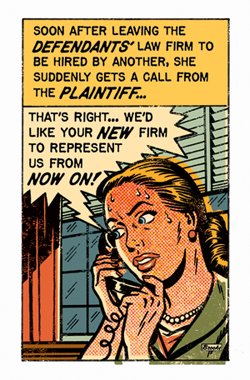
THE WAY OUT: Know—or Learn—the Law
BY STEPHEN GILLERS
If I had a quarter for every time I heard about a firm that got itself in a pickle because of a failure to anticipate conflicts, I could buy dinner for eight at a top Manhattan restaurant. With wine. Good wine.
Kaye Scholer did try to plan ahead in the gabapentin action, and there are good arguments why consent from Ivax should have sufficed. I think Judge Lifland’s decision to find an implied attorney-client relationship between Lindvall and Clarke and the other defendants was wrong. But he’s the judge, and his ruling did not come out of left field. It was foreseeable.
The trouble is—and here’s the lesson—lawyers may assume they know more than they do about complex legal ethics questions like this one, and they make fatal errors as a result. They would never do that in any other field of law. Would an antitrust lawyer who ran into a complicated intellectual property question make an educated guess at the answer? No! He or she would consult an IP lawyer or do some serious research. Doing neither would be malpractice.
Yet for some reason, lawyers assume that when the specialized field is lawyer ethics, they’ll reach the right answer intuitively. Based on what? The legal ethics class they took 10 or 20 years ago in law school?
Maybe correct intuitive answers were possible in the 1970s or ’80s. But those days are long gone. The law and ethics of lawyering is a specialty and, like other fields, it is constantly changing. When the consequences of error can be unpleasant (or worse) for you or your client, and you haven’t got the time or inclination to research a question, consult an expert.
Stephen Gillers is a professor at New York University School of Law. He chairs the Policy Implementation Committee in the ABA Center for Professional Responsibility.
THE TRAP: Fee Agreements
Harry Issler was listed as counsel of record on a medical-malpractice case, even though he referred the case to Greg Starr. The two New York lawyers entered into a fee-sharing agreement in 1999, when they shared office space. Their work relationship soured in 2001, when Issler lost his lease and would not sublet space to Starr at his new office.
The malpractice case settled for $135,000 and Issler claimed half the fee. Starr argued that the clients had named him sole counsel in the case, and that Issler should receive a quantum meruit amount that he estimated at only 4 percent of the fee.
Judge Dianne T. Renwick rejected Starr’s quantum meruit claim because he offered no proof that the substitution of attorneys had met statutory requirements that Issler consent or that a court order be obtained.
The court also rejected Starr’s argument that the fee-sharing agreement violated the New York Code of Professional Responsibility. The state code says, in effect, that unaffiliated lawyers may share fees proportional to their actual work or by terms of a written client agreement assigning “joint responsibility.”
Renwick held that, under the New York ethics code, joint responsibility essentially means that the referring lawyer—in this case, Issler—assumes joint and several liability for any act of malpractice, even if he or she has no ethical obligation to supervise the work of the lawyer to whom the case was referred. The judge ruled that the language of their fee agreement met that requirement.
THE WAY OUT: Be Clear on Responsibilities
BY PETER H. GERAGHTY
Like New York’s code, ABA Model Rule 1.5 permits lawyers who are not in the same firm to share fees in either of two ways: first, on the basis of the amount of work each lawyer performs in the matter; or second, if by written agreement with the client, each lawyer assumes joint responsibility for the matter.
The Comment to Rule 1.5 states: “Joint responsibility for the representation entails financial and ethical responsibility for the representation as if the lawyers were associated in a partnership.”
The ABA House of Delegates added that definition to the Comment in 2002 to clarify that lawyers who share fees on a joint responsibility basis in effect become partners for purposes of the representation, and assume financial, legal and ethical responsibility for the matter that would also presumably include a duty to supervise under Model Rule 5.1 See also, ABA Informal Opinion 85-1514 (1985), which is still widely used.
State ethics opinions do not agree on what is meant by joint responsibility. The State Bar of Wisconsin (Opinion E-00-01) found in 2000 that the referring lawyer has a duty to make competent referrals, must remain sufficiently aware of the performance of the lawyer to whom the matter was referred, and must assume financial responsibility for the matter. But Arizona Bar Association Opinion 04-02 (2004) states that the requirement is satisfied if a lawyer assumes financial responsibility for any malpractice.
Before agreeing to share fees on a joint responsibility basis, lawyers would be well-advised to check their jurisdictions’ rules of professional conduct, ethics opinions and case law to fully understand the extent of their ethical and legal obligations.
Peter H. Geraghty is director of ETHICSearch in the ABA Center of Professional Responsibility.
THE TRAP: Ending the Lawyer-Client Relationship
When lawyers at Gordon, Thomas, Honeywell, Malanca, Peterson & Daheim in Tacoma, Wash., were asked to help represent Rabanco Ltd. employees in a suit against the company, they jumped right in. They did not think an earlier representation of a wholly owned subsidiary of the company disqualified them.
But a U.S. District Court in Seattle saw things differently. Judge Marsha J. Pechman granted the defendants’ motion that the firm be disqualified.
The firm argued no one from Rabanco nor its subsidiaries had contacted it in three-plus years. But Pechman noted that the firm had open files on matters involving the Rabanco family of companies, was listed as receiving notices in a settlement agreement, and continued to store documents from the earlier case. Jones v. Rabanco Ltd., No. C03-3195P (W.D. Wash. Aug. 3, 2006).
THE WAY OUT: Don’t Rely on Your Assumptions
BY STEPHEN GILLERS
Jones v. Rabanco is a pretty aggressive opinion. Many courts would have ruled differently. Lawyers can do much to insulate themselves from decisions like this one, but only if they know how the rules treat current and former clients differently, and they inform the client that it has moved from the first category to the second if the transition is not clear.
First, the conflict rules are less strict in defining the duty owed to former clients. Most important, under Rule 1.9(a) of the ABA Model Rules of Professional Conduct, the duty to former clients exists only to avoid subsequent adverse representation in substantially related matters. On the other hand, a firm may not ordinarily be adverse to a current client on any matter without informed consent. See ABA Model Rule 1.7(a)(2).
Second, Model Rule 1.4, along with fiduciary duty and malpractice law, requires lawyers to keep current clients informed about factual and legal developments related to their matters. This duty is not ordinarily owed to former clients unless the lawyer promises otherwise. See Lama Holding Co. v. Shearman & Sterling, 758 F. Supp. 159 (S.D.N.Y. 1991), in which the court refused to dismiss a complaint alleging that the firm failed to apprise a former client of tax law changes despite a promise to do so.
Of course, whether a client is current or former is not always within your power to control. You can’t drop a client simply to enjoy the more generous former-client conflict rules. But if the work is done, the firm can make that fact clear to the client, rather than leave things vague.
When I explain this to lawyers, they often admit that they prefer to leave things vague because that means the client will likely think of them as “my lawyer,” which increases the chance for new work. Fine. That’s a business decision, but it comes at a price.

